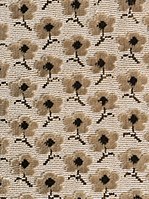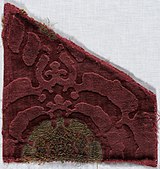Velvet
This article needs additional citations for verification. (August 2021) |

Velvet is a type of woven fabric with a dense, even pile[1] that gives it a distinctive soft feel. By extension, the word velvety means "smooth like velvet". Historically, velvet was typically made from silk. Today, velvet can be made from silk, linen, cotton, wool, synthetic fibers, silk-cotton blends, or synthetic-natural fiber blends.[2]
Construction and composition

Velvet is woven on a special
Velvet can be made from several different kinds of fibers, the most expensive of which is
Velvet has a thick pile and can be cut 'pile up' or 'pile down' for more shine or more saturated color.[6]
History
Because of its unusual softness and appearance as well as its high cost of production, velvet has often been associated with nobility. Velvet was introduced to
King Richard II of England directed in his will that his body should be clothed in velveto in 1399.[7]

The Encyclopædia Britannica Eleventh Edition described velvet and its history thus:
VELVET, a silken textile fabric having a short dense piled surface. In all probability the art of velvet-weaving originated in the Far East; and it is not till about the beginning of the 14th century that we find any mention of the textile. The peculiar properties of velvet, the splendid yet softened depth of dye-colour it exhibited, at once marked it out as a fit material for ecclesiastical
Types
- Chiffon (or transparent) velvet
- very lightweight velvet on a sheer silk or rayon chiffon base.[11]
- Ciselé
- velvet where the pile uses cut and uncut loops to create a pattern.[11]
- Crushed
- lustrous velvet with patterned appearance that is produced by either pressing the fabric down in different directions, or alternatively by mechanically twisting the fabric while wet.[12]
- Devoré or burnout
- a velvet treated with a caustic solution to dissolve areas of the pile, creating a velvet pattern upon a sheer or lightweight base fabric.[12]
- Embossed
- velvet on which a metal roller has been used to heat-stamp the fabric, producing a pattern.[12]
- Hammered
- an extremely lustrous velvet with a crushed and dappled appearance.[12]
- Lyons
- a densely woven, stiff, heavier-weight pile velvet used for hats, coat collars and garments.[11][13]
- Mirror
- a type of exceptionally soft and light crushed velvet.[13]
- Nacré
- velvet with an effect similar to shot silk where the pile is woven in one or more colours and the base fabric in another, creating a changeable, iridescent effect.[11][13]
- Panne
- a type of crushed velvet produced by forcing the pile in a single direction by applying heavy pressure.[14] Sometimes, less frequently, called paon velvet.[15] However, since the 1970s, "panne velvet" as used in ordinary fabric stores has referred to a pile knit, perhaps better called a velour, with a short pile that falls in many directions; usually of polyester.
- Pile-on-pile, also called double velvet
- a particularly luxurious type of velvet woven with piles of differing heights to create a pattern. It is one of the oldest known velvet weaving techniques.[16][17][18]
- Plain
- velvet commonly made of cotton with a firm hand.[12]
- Ponson
- A very heavy and quite expensive velvet made either entirely with silk or having a pile exclusively of silk, used at one point for women's dresses and cloaks
- Utrecht
- a pressed and crimped velvet associated with Utrecht, the Netherlands.[11]
- Voided
- velvet deliberately woven with areas of pile-free ground (usually satin) forming a pattern.[19]
- Wedding ring or ring velvet
- another term for devoré and/or chiffon velvets which are allegedly fine enough to be drawn through a wedding ring.[20]
Fibers
This section relies largely or entirely upon a single source. (August 2021) ) |
- Cotton
- Cotton velvet is highly durable, but lacks much of the luxuriousness of other varieties of velvet, and its colors tend not to be as deep or rich
- Silk
- Silk velvet is one of the more expensive kinds of velvet, and is usually shinier and softer than the cotton variety[12]
- Microfiber
- Microfiber velvet is a synthetic polyester variety of the fabric that resists stains easily and is lightweight
- Nylon/rayon blend
- Nylon/rayon blend velvet has much of the feel and drape of silk-based velvet, but is usually much less expensive; also, it is easier to care for than silk velvet
- Polyester/spandex
- Polyester/spandex velvet (often called "stretch velvet") can be made of polyester with a small percentage of spandex to allow it to stretch in one or two directions
- Viscose
- In terms of quality, viscose velvet is more similar to silk velvet than cotton velvet as it is softer and richer than the cotton[12]
Gallery
This section contains an unencyclopedic or excessive gallery of images. |
-
Ciselé
-
Devoré
-
Embossed
-
Pile-on-pile
-
Voided
See also
References
- ^ "Velvet | fabric | Britannica". www.britannica.com. Retrieved 2023-03-24.
- ^ "The 7 Things You Need to Know About Velvet".
- ^ Reath, Nancy Andrews (April 1927). "Weaves in Hand-Loom Fabrics". Bulletin of the Pennsylvania Museum. 22 (112): 358–366. Retrieved 23 January 2024.
- ISBN 978-1-59217-018-0.
- ^ "What Is Velvet? A Guide to the Different Types of Velvet". MasterClass. Retrieved 23 January 2024.
- ^ "Velvet vs Velour vs Velveteen: how to Choose, Sew and Care". Dalston Mill Fabrics. Retrieved 23 January 2024.
- ISBN 1-85326-378-8.
- ^ "Top Velvet".
- ^ "Discover the velvet hair fabric".
- ^ One or more of the preceding sentences incorporates text from a publication now in the public domain: Chisholm, Hugh, ed. (1911). "Velvet". Encyclopædia Britannica. Vol. 27 (11th ed.). Cambridge University Press. pp. 979–980.
- ^ ISBN 9788183242059.
- ^ a b c d e f g "Free patterns - Velvet". sewingtechnology.net. Archived from the original on 2011-02-23.
{{cite web}}: CS1 maint: unfit URL (link) - ^ ISBN 9781440220333.
- ^ "Fabric Properties and Distinctions - Velvet". fabrics.net. Archived from the original on 2010-12-17.
{{cite web}}: CS1 maint: unfit URL (link) - ^ Denny, Grace Goldena (1947). Fabrics. J. B. Lippincott Company. p. 77.
Panne or paon velvet. Finish on lightweight velvet. Pile laid flat in one direction.
- ^ Rosalie Gilbert. "Rosalie's Medieval Woman".
- ISBN 9781606060803.
- ISBN 9781843832393.
- ISBN 9781135145200.
- ^ Strong Hillhouse, Marian (1963). Dress selection and design. Macmillan. p. 156.
Chiffon velvet is also called "wedding ring velvet," because it is supposedly so light _and soft it can be pulled through a wedding ring.
External links
 Media related to Velvet at Wikimedia Commons
Media related to Velvet at Wikimedia Commons





